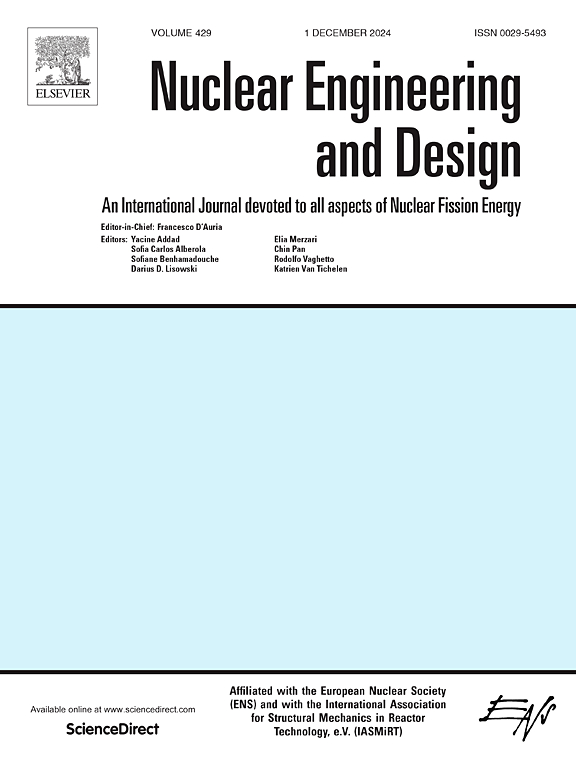Comprehensive evaluation of nuclear data library variations and TRISO distribution methods on neutronic properties of HTR-10 pebble-bed fuel using OpenMC
IF 2.1
3区 工程技术
Q1 NUCLEAR SCIENCE & TECHNOLOGY
引用次数: 0
Abstract
The HTR-10 reactor requires highly complex modeling, particularly in pebble distribution within the core and TRISO particle distribution within the pebbles. This complexity significantly impacts the suitability of nuclear data library selection and the accuracy of model simplifications to enhance computational efficiency. While most related studies focused on k-eigenvalue calculations, they often overlooked depletion calculations, which were essential for determining reactor operational lifetime. This study comprehensively evaluated the impact of four nuclear data libraries (ENDF/B-VIII.0, ENDF/B-VII.1, JEFF-3.2, and JEFF-3.3) and three TRISO distribution methods (random lattice, hexagonal lattice, and rectangular lattice) on the neutronic characteristics of HTR-10 pebble-bed fuel, including k-eigenvalue, material depletion, and the dominant physical properties influencing these parameters. The results indicated that all four data libraries provided consistent criticality calculations, but significant differences were observed in material depletion, particularly between ENDF/B-VIII.0 and ENDF/B-VII.1, with relative difference remaining below 1.00 %. The geometric simplification aspect that was implemented resulted in a sixfold reduction in computation time for k-eigenvalue calculations and a 43-fold reduction for depletion calculations, without compromising accuracy or precision, maintaining differences below 1.00 % for k-eigen, material depletion, and other physical parameters. Notable discrepancies between simplified and random models were primarily observed in reaction rate distributions, yet these did not substantially affect total reaction rate calculations, with relative errors remaining under 1.5 × 10−3. These findings highlighted that simplifying TRISO distribution using hexagonal lattice and rectangular lattice significantly enhanced the efficiency of HTR-10 pebble-bed fuel analysis without causing significant deviations in accuracy or precision.
利用OpenMC综合评价HTR-10球床燃料中子特性的核数据库变化和TRISO分布方法
HTR-10反应堆需要高度复杂的建模,特别是堆芯内的卵石分布和卵石内的TRISO颗粒分布。这种复杂性严重影响了核数据库选择的适宜性和模型简化提高计算效率的准确性。虽然大多数相关研究集中在k特征值计算上,但它们往往忽略了耗尽计算,而耗尽计算对于确定反应堆的运行寿命至关重要。本研究全面评估了四个核数据库(ENDF/B-VIII)的影响。0, ENDF / B-VII。1、JEFF-3.2和JEFF-3.3)和三种TRISO分布方法(随机点阵、六边形点阵和矩形点阵)对HTR-10球床燃料中子特性的影响,包括k特征值、材料耗竭以及影响这些参数的主要物理性质。结果表明,所有四个数据库提供了一致的临界计算,但在材料消耗方面观察到显着差异,特别是在ENDF/B-VIII之间。0和ENDF/B-VII。1,相对差值保持在1.00%以下。实现的几何简化方面导致k特征值计算的计算时间减少了6倍,损耗计算减少了43倍,而不影响准确性或精度,将k特征、材料损耗和其他物理参数的差异保持在1.00%以下。简化模型和随机模型之间的显著差异主要体现在反应速率分布上,但这些差异并没有实质性地影响总反应速率的计算,相对误差保持在1.5 × 10−3以下。这些发现表明,使用六边形晶格和矩形晶格简化TRISO分布可以显著提高HTR-10球床燃料分析的效率,而不会导致准确性或精度的显著偏差。
本文章由计算机程序翻译,如有差异,请以英文原文为准。
求助全文
约1分钟内获得全文
求助全文
来源期刊

Nuclear Engineering and Design
工程技术-核科学技术
CiteScore
3.40
自引率
11.80%
发文量
377
审稿时长
5 months
期刊介绍:
Nuclear Engineering and Design covers the wide range of disciplines involved in the engineering, design, safety and construction of nuclear fission reactors. The Editors welcome papers both on applied and innovative aspects and developments in nuclear science and technology.
Fundamentals of Reactor Design include:
• Thermal-Hydraulics and Core Physics
• Safety Analysis, Risk Assessment (PSA)
• Structural and Mechanical Engineering
• Materials Science
• Fuel Behavior and Design
• Structural Plant Design
• Engineering of Reactor Components
• Experiments
Aspects beyond fundamentals of Reactor Design covered:
• Accident Mitigation Measures
• Reactor Control Systems
• Licensing Issues
• Safeguard Engineering
• Economy of Plants
• Reprocessing / Waste Disposal
• Applications of Nuclear Energy
• Maintenance
• Decommissioning
Papers on new reactor ideas and developments (Generation IV reactors) such as inherently safe modular HTRs, High Performance LWRs/HWRs and LMFBs/GFR will be considered; Actinide Burners, Accelerator Driven Systems, Energy Amplifiers and other special designs of power and research reactors and their applications are also encouraged.
 求助内容:
求助内容: 应助结果提醒方式:
应助结果提醒方式:


